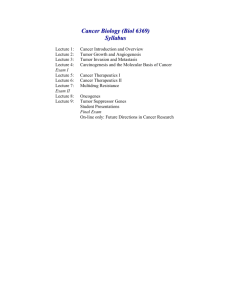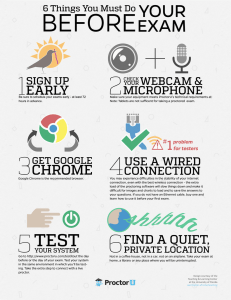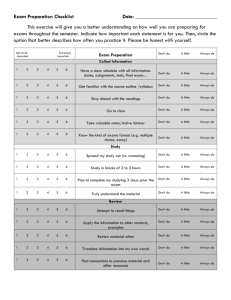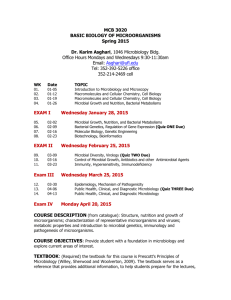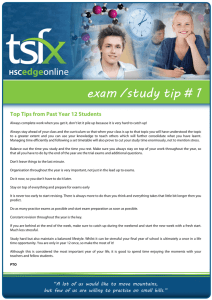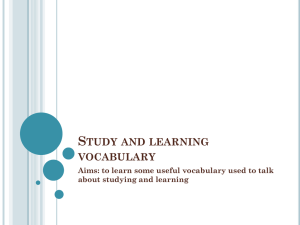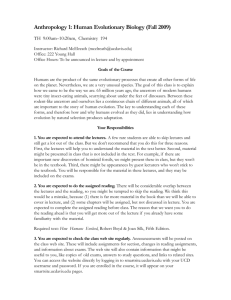BS301 - HUMAN GROSS ANATOMY
advertisement
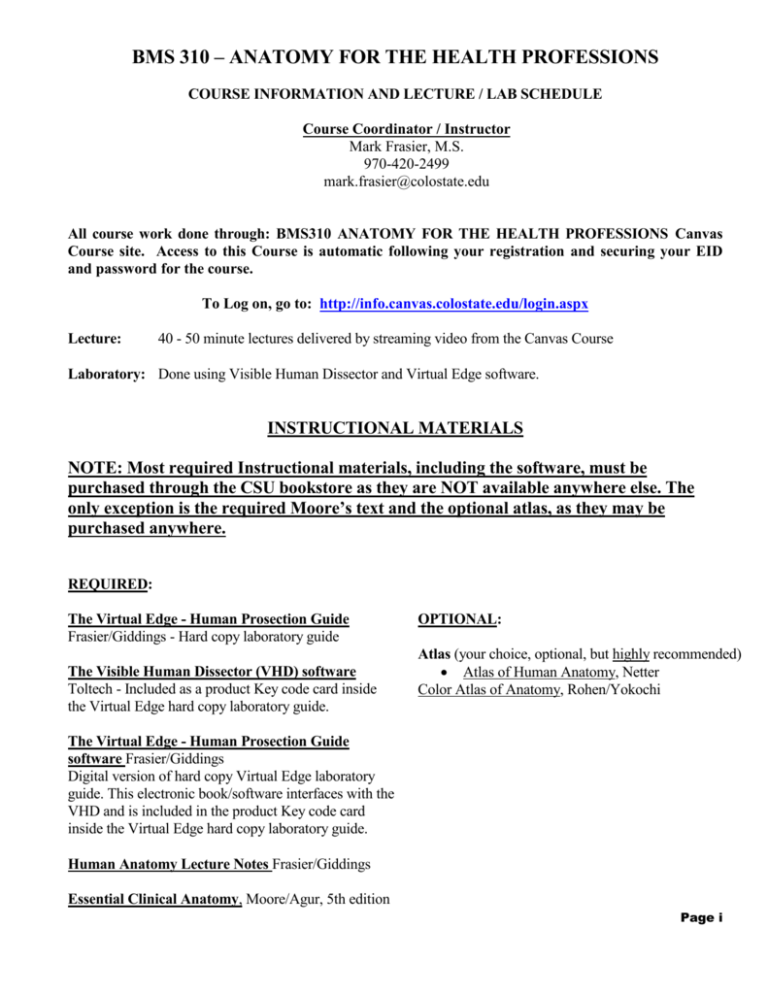
BMS 310 – ANATOMY FOR THE HEALTH PROFESSIONS COURSE INFORMATION AND LECTURE / LAB SCHEDULE Course Coordinator / Instructor Mark Frasier, M.S. 970-420-2499 mark.frasier@colostate.edu All course work done through: BMS310 ANATOMY FOR THE HEALTH PROFESSIONS Canvas Course site. Access to this Course is automatic following your registration and securing your EID and password for the course. To Log on, go to: http://info.canvas.colostate.edu/login.aspx Lecture: 40 - 50 minute lectures delivered by streaming video from the Canvas Course Laboratory: Done using Visible Human Dissector and Virtual Edge software. INSTRUCTIONAL MATERIALS NOTE: Most required Instructional materials, including the software, must be purchased through the CSU bookstore as they are NOT available anywhere else. The only exception is the required Moore’s text and the optional atlas, as they may be purchased anywhere. REQUIRED: The Virtual Edge - Human Prosection Guide Frasier/Giddings - Hard copy laboratory guide The Visible Human Dissector (VHD) software Toltech - Included as a product Key code card inside the Virtual Edge hard copy laboratory guide. OPTIONAL: Atlas (your choice, optional, but highly recommended) Atlas of Human Anatomy, Netter Color Atlas of Anatomy, Rohen/Yokochi The Virtual Edge - Human Prosection Guide software Frasier/Giddings Digital version of hard copy Virtual Edge laboratory guide. This electronic book/software interfaces with the VHD and is included in the product Key code card inside the Virtual Edge hard copy laboratory guide. Human Anatomy Lecture Notes Frasier/Giddings Essential Clinical Anatomy, Moore/Agur, 5th edition Page i COURSE INFORMATION Prerequisites Basic Biology Course Description and Goals BMS 310 presents the gross anatomy of the human body from a regional perspective, utilizing clinical applications as a basis for anatomical understanding. Other disciplines such as physiology, embryology, histology and anthropology will also be included when they assist in anatomical understanding. The lecture portion of the course will include: 1. The skeletal, muscular, vascular, and nervous system components of the upper and lower extremities. 2. The vascular, nervous and organ system components of the thorax, abdomen and pelvis. 3. The musculature and vasculature of the head, neck and back. 4. An overview of cranial nerves and the central nervous system. The laboratory portion of the course includes: 1. Computer facilitated study using The Visible Human Dissector (VHD) & The Virtual Edge anatomy software. Emphasis on identifying relationships and locations of anatomical structures as well as practicing anatomical vocabulary. The lecture and laboratory are intimately correlated and inseparable. The course has been designed to fit the needs of students preparing for careers in health related fields such as Fitness and Athletics; Pre-Medicine; Pre-Physical and Occupational Therapy; Pre-Physician Assistant; Nursing; Bio-Education (Teachers!), as well as students simply interested in their own physical construction. Page 2 BMS 310 ANATOMY FOR THE HEALTH PROFESSIONS The following schedule lists the lectures and laboratories for each of the 4 units of study. The lectures can be found on the BMS310 Canvas course Home page in the 4 Units of study. The laboratory portion will be done using the Visible Human Dissector and the Virtual Edge. Readings can be found in Essential Clinical Anatomy by Moore and Agur, 5th Ed. UNIT 1 - LOWER LIMB SECTION 1 Lectures Introduction to Human Gross Anatomy – (Also found in Introduction module) Introduction to the Lower Limb The Gluteal Region Laboratory Open book assessment #1 - (4pts) & Ex. 1* & 13, The Virtual Edge * Ex.1 only “Anatomy common to all vertebrae” & “Anatomy common to sacral vertebrae” - Readings pp 1–27 & 195-201 & 309–322 & 337-340 & 369-374 SECTION 2 Lectures Introduction to the Nervous system Nerve & Blood supply of the lower limb The Knee Readings pp 27-33 & 184 & 208-209 & 324-329 & 331-337 & 337-348 & 359 & 365 & 374-384 Laboratory Open book assessment #2 - (4pts) & Ex. 14, The Virtual Edge SECTION 3 Lectures The Thigh The Ankle & leg The Foot Readings pp 329-337 & 342 & 346-367 & 385-395 Laboratory Open book assessment #3 - (4pts) & Ex. 15 & 16, The Virtual Edge LECTURE EXAM UNIT 1 LAB PRACTICAL EXAM UNIT 1 Page 3 UNIT 2 – THORAX, ABDOMEN AND PELVIS SECTION 1 Lectures The Vertebral column Muscles of back The Spinal cord Readings pp 265-284 & 295-308 & 288-294 Laboratory Open book assessment #4 - (4pts) & Ex. 1, The Virtual Edge Section 2 Lectures The Thorax & lungs The Heart Coronary circulation & Fetal circulation Readings pp 43-51 & 56-64 & 64-76 & 76-110 Laboratory Open book assessment #5 - (4pts) & Ex. 2, The Virtual Edge SECTION 3 Lectures The Abdominal wall & Peritoneum The Abdominal viscera The Abdominal viscera Blood supply and Return Readings pp 111-123 & 130-194 Laboratory Open book assessment #6 - (5pts) & Ex. 3, The Virtual Edge SECTION 4 Lectures Male Reproductive anatomy Female Reproductive anatomy The Autonomic nervous system Laboratory No open book assessment & Ex. 4, The Virtual Edge Readings pp 211-264 & 33-42 LECTURE EXAM UNIT 2 LAB PRACTICAL EXAM UNIT 2 Page 4 UNIT 3 – HEAD AND NECK SECTION 1 Lectures The Skull The Brain Arterial supply to the head Laboratory Open book assessment #7 (4pts) & Ex. 5, The Virtual Edge Readings pp 485-493 & 543-544 & 561-566 & 501 & 510-514 & 505-507 SECTION 2 Lectures Cranial Meninges & Venous return from the Head & Brain Cerebrospinal fluid & the Ventricular system TheCranial nerves & Facial nerve CN VII) Laboratory Open book assessment #8- (4 pts), & Ex. 7, The Virtual Edge Readings pp 492-500 & 501-504 & 507-510 & 514-518 & 644-646 SECTION 3 Lectures Trigeminal nerve (CNV) & Muscles of mastication The Neck & Cervical viscera Laboratory Open book assessment #9 - (4pts), & Ex. 6, The Virtual Edge Readings pp 642-644 & 537-561 & 581-608 SECTION 4 Lectures Pharynx Larynx Eye (part I) Eye (part II) Laboratory No Open book Assessment & Ex. 8, The Virtual Edge Readings pp 616-626 & 608-615 & 518-536 LECTURE EXAM UNIT 3 LAB PRACTICAL EXAM UNIT 3 Page 5 UNIT 4 - UPPER LIMB SECTION 1 Lectures Shoulder Region Pectoral and Shoulder muscles Laboratory Open book assessment # 10 - (4pts) & Ex. 9, The Virtual Edge Readings pp 465-471 & 397-411 & 414- 419 SECTION 2 Lectures Axilla and breast Brachial plexus Upper limb Blood supply & return Laboratory Open book assessment # 11 - (4 pts) & Ex 10, The Virtual Edge Readings pp 419-425 & 52-56 & 425-431 & 409 - 410 & 432-434 & 452-453 & 458-464 SECTION 3 Lectures Elbow & Arm Articulations of Distal Upper Limb Muscles of the Forearm Laboratory – Open book assessment #12 - (4pts), & Ex. 11, The Virtual Edge Readings pp 472-477 & 432-438 & 475-484 & 438-451 SECTION 4 Lectures The Hand Laboratory No open book assessment, & Ex. 12, The Virtual Edge Readings pp 451-464 LECTURE EXAM UNIT 4 LAB PRACTICAL EXAM UNIT 4 OPTIONAL COMPREHENSIVE FINAL (If Student elects to take) Page 6 EXAMINATION AND GRADING POLICIES Lecture Exams: There are four lecture unit exams each one worth 50 points for a total of 200 points. Each unit exam will emphasize the material in that unit. Questions will be taken from the video lectures. These are closed book exams, taken using our Canvas website and proctored through ProctorU. Lab Exams: There are four laboratory unit exams each one worth 50 points for a total of 200 points. Questions will be identification of tagged structures on the VHD from that unit. These are closed book/software exams, taken using our Canvas website and proctored through ProctorU. Lab Assessments: There are 12 laboratory assessments each worth 4 or 5 points for a total of 50 points. Questions will be taken from the syllabus; the VHD; The Virtual Edge and/or that laboratory exercise. These assessments should be taken after each appropriate laboratory exercise. These assessments are not proctored and are open book; open note; open software and are taken using our Canvas website. Comprehensive final: An optional final comprehensive lecture exam will be available for students whose overall grade may be improved by taking it. The optional final comprehensive exam score can replace, if higher, any one of the four lecture unit exams. This exam is taken using our Canvas web site and proctored through ProctorU. There are no points given for any of the practice exams or the academic integrity agreement. The final grade will be computed from the grades of the four unit lecture exams (200 points), four unit laboratory exams (200 points), and twelve open book assignments (50 points), for a total of 450 points. You can determine your overall grade at any time during the semester by dividing your actual points by the total points possible to that date. There are no curves in BMS310 and letter grades will be as follows: A= B= C= D= F = 90% -100% 80% - 89% 70% - 79% 60% - 69% Below 60% = = = = = 405 points and above 360 – 404 points 315 – 359 points 270 – 314 points 269 points and below Page 7 EXAMINATIONS AND PROCTORS Colorado State University has contracted with ProctorU.com to provide students in BMS 310 the most convenient, at home, on line exam proctoring system. This system provides a simple, no cost to the student, secure, on line proctor for all of the BMS 310 exams and allows the student to take all of the exams at home and on their own schedule. DUE TO THE NUMBER OF STUDENTS IN BMS 310 – ANATOMY FOR THE HEALTH PROFESSIONS, THE ONLY WAY EXAMS CAN BE DONE IS THROUGH PROCTORU. IF YOU DO NOT HAVE THE NECESSARY SYSTEM REQUIREMENTS OR FOR WHATEVER OTHER REASON CANNOT USE/ACCESS PROCTORU, YOU CANNOT TAKE THIS COURSE – BMS310. Please see system requirements below to ensure you have the necessary computer setup to use ProctorU. SYSTEM REQUIREMENTS FOR USE OF PROCTORU MINIMUM RECOMMENED Web camera 640x480 resolution 1280x720 resolution PC Users Windows XP Windows 8 Mac Users Mac OS X or higher Mac OS X 10.9 Maverick Internet Download Speed .768 Mbps 1.5Mbps Internet Upload Speed .384 Mbps 1.5 Mbps RAM 1024M 2GB Ports 1935, UDP/TCP 1935, UDP/TCP Page 8 Other Requirements 1. A functioning microphone (sometimes web cameras have built-in microphones). 2. One of the following compatible web browsers (click to download): o Google Chrome (preferred) o Mozilla Firefox o Safari o Internet Explorer 7, 8, 9, 10 3. The following plugins for your web camera (click to download): o Adobe Flash Player v11 o Adobe Shockwave player Not Supported At this time we do not support the following; however, we are working on solutions to accomodate every platform. 1. Google Chromebooks 2. Android tablets (Nexus 7, etc.) 3. iOS tablets (iPad, iPad mini, etc.) 4. Linux operating systems 5. Microsoft Surface RT Questions about your equipment? After testing it yourself contact ProctorU for a test They are happy to help! Note: ProctorU does not proctor computers running virtual machines. If you are running a virtual machine when you come in, you will be asked to close your virtual machine and boot into your actual operating system to take your test. Note: ProctorU does not support development previews, beta builds, or release candidates of any operating system unless specified. Page 9 Get Started With GETTING STARTED WITH PROCTORU To register with ProctorU and set up a free account, go to: www.proctoru.com and click on “Getting Started”, then click on “create an account” and then you can set up your account. If you need further assistance, one of ProctorU’s desk representatives will be more than happy to help schedule an exam for you. When ready, students will schedule their exams with ProctorU at least 3 days (BMS310 policy) prior to taking that exam. Upon the exam day and hour, students will log in to proctor U and click on “exams”. Following the procedures outlined at ProctorU’s web site, the student will log in to Canvas, open the appropriate exam and the proctor will then allow student access to that exam. Students will need to plan on, and schedule through ProctorU, a total of 2 consecutive hours for each of the 4 module exams - one hour for each Unit lecture exam and one hour for each Unit laboratory exam, both done in the same 2 hour time block. You need not schedule all of the unit exams at once, but each one must be scheduled at least 3 days (BMS310 policy) in advance of the actual exam date. At the end of the course, students may elect to take the comprehensive final to improve their total score – see under exams and grades, in which case they will need to schedule a one hour time block with ProctorU for that exam. DO NOT SCHEDULE AN EXAM AT THE LAST MINUTE! WARNING: NOT SHOWING FOR EXAMS OR SCHEDULING AND THEN REPEATEDLY CANCELLING SCHEDULED EXAMS, ESPECIALLY AT THE LAST MINUTE, COULD RESULT IN THE STUDENT LOSING THEIR PROCTORU SERVICE! WITHOUT PROCTORU, THE STUDENT WILL NOT BE ABLE TO TAKE EXAMS AND THUS NOT BE ABLE TO FINISH THE COURSE! NOTE: While the following information is against BMS310 policy and could result in not having your exam reviewed by the instructor, if you do – BAD IDEA, schedule or reschedule your exam within three hours of your current time, there is an $8.75 ProctorU premium attached to the exam, known as the "Take It Now" option. If you schedule or reschedule your exam within 72 hours of your current time, there is a $5.00 ProctorU premium attached to the exam. If you have previously paid the $5.00 premium for this exam and want to reschedule within three hours of your current time, an additional $3.75 premium will be attached to bring it up to par with the "Take It Now" option. Page 10 COURSE LENGTH AND EXTENSIONS 1. Courses in the On line program are equivalent to one semester courses designed to be completed in 16 weeks. 2. Many students are nontraditional students who have elected an on-line course for its flexibility. Therefore students may complete the course in less than 16 weeks or they may take as long as 4 months. 3. Enrollment in the course will begin on the day that your registration is processed, which is usually 2448 hours after the day you register. 4. BMS 310 is an open entry course. Open enrollment (open entry) courses . BMS310 gives you four months to complete the course from the day your registration is processed, allowing you to work at your own pace. 5. Students who have not completed the course by 16 weeks (4 months) may request an extension with the instructor and if granted will be given an extra 10 weeks and assigned an Incomplete grade. If the course is not completed within the 10 week extension time, the Incomplete will be changed to an Administrative F. Drop a Course – Within 14 days of Registration - No record on transcript Withdraw from a course, 14 - 65 days of Registration - W grade recorded on transcript. Drops/Withdraws must be requested through one of the methods below; no drops can be completed via telephone. Online: RAMweb and click on "Registration" to get started. Email: Send an email to onlineplus_registration@colostate.edu and include your name, CSUID, and the course(s). Fax: (970) 491-7885 You will receive confirmation of your course changes. It is your responsibility to retain registration documents as proof of course changes. After 65 days from registration students are not able to withdraw from the course unless extenuating circumstances exist. In that case, the student can file a late withdraw appeal by going to http://www.online.colostate.edu/answers/policies/appeals.dot and submit it to OnlinePlus. Refunds Drop course within 14 calendar days of registration – 100% REFUND After 14 calendar days from registration – NO REFUND Page 11 TRANSCRIPTS Official Colorado State University transcripts can be ordered through the Registrar’s office by going to www.registrar.colostate.edu and then clicking on “Transcript Ordering” in the left hand menu. Please make sure your BMS310 grade has been posted on your unofficial transcript from Ramweb BEFORE you order an official transcript. Page 12
